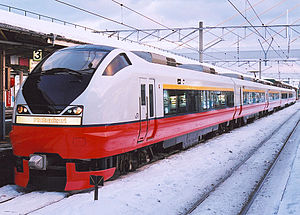|
Hatsukari
The Hatsukari (はつかり) and Super Hatsukari (スーパーはつかり) were limited express train services in Japan operated by Japanese National Railways (JNR) and later East Japan Railway Company (JR East) from 1958 until 2002.[1] HistoryThe Hatsukari was first introduced on 1 October 1958 as a long-distance steam-hauled limited express service operating between Ueno in Tokyo and Aomori via the Jōban Line.[2] From 1960, new KiHa 81 series diesel multiple units were introduced on the service,[3] reducing the journey time to 10 hours 25 minutes. From 1 October 1968, the train was amended via the more direct Tōhoku Main Line using 583 series electric multiple units.[2] From 15 November 1982, with the opening of the Tōhoku Shinkansen to Morioka, the Hatsukari service was shortened to operate between Morioka and Aomori. This was extended to operate to Hakodate in Hokkaido from 13 March 1988, following the opening of the undersea Seikan Tunnel.[1] The maximum speed was raised to 140 km/h (85 mph) through the Seikan Tunnel from 16 March 1991.[4] New E751 series electric multiple units were introduced from 18 March 2000, with the trains running as Morioka – Aomori Super Hatsukari alongside the Morioka – Hakodate Hatsukari services using 485-3000 series EMUs.[1] The Super Hatsukari and Hatsukari services were discontinued from the start of the revised timetable on 1 December 2002, with the opening of the Tōhoku Shinkansen extension to Hachinohe, and were superseded by new Hakuchō and Super Hakuchō services operating from Hachinohe to Hakodate. The E751 series EMUs were transferred to new Tsugaru limited express services operating between Hachinohe and Hirosaki.[1] Rolling stock
See alsoReferences
|
||||||||||||||||||||||||||||||||||




